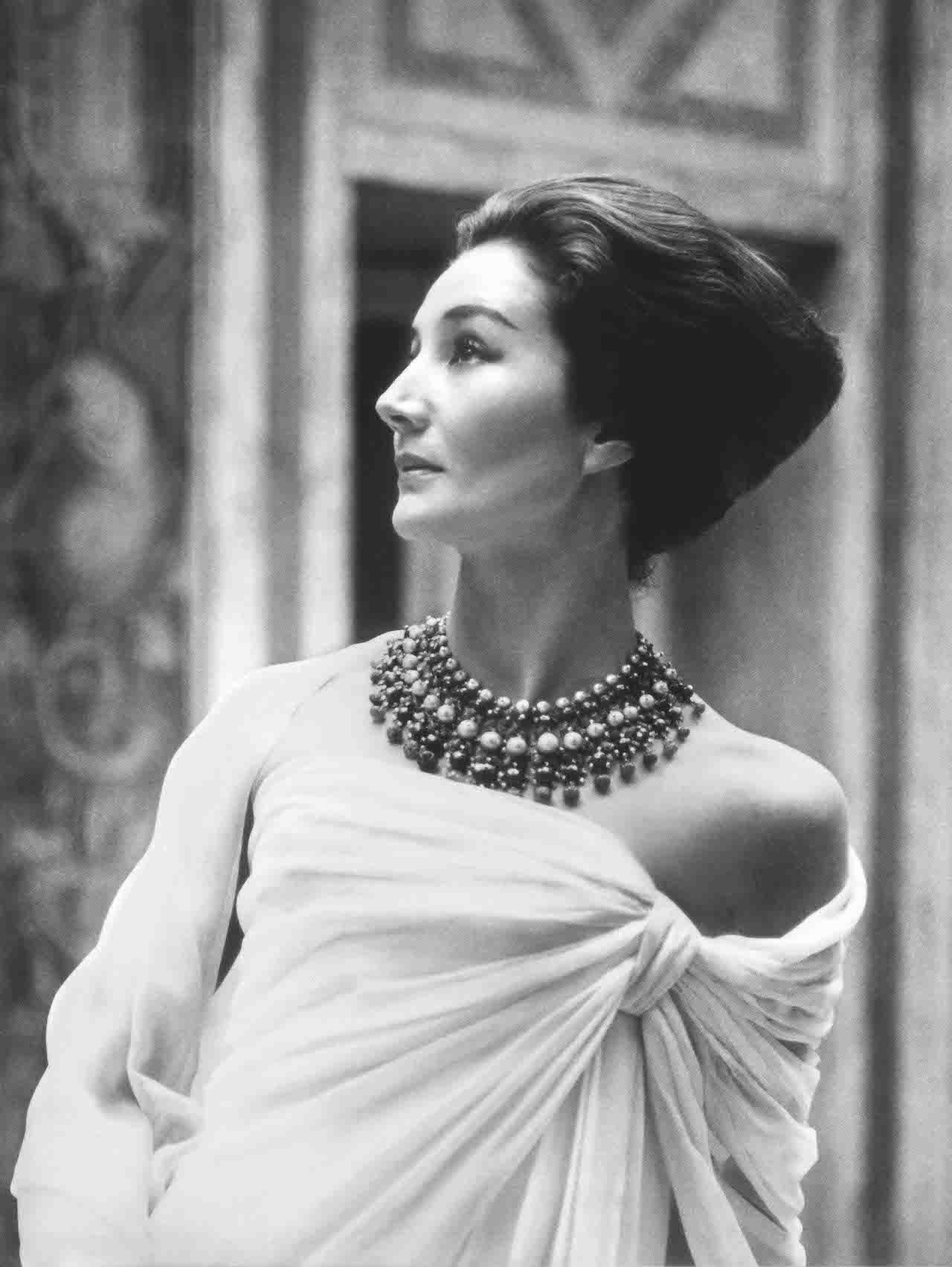A Fashion Icon Who Championed the Power of Personal Style: Jaqueline de Ribes

Roloff Beny, “Jaqueline de Ribes in Christian Dior” (1959) (courtesy the Metropolitan Museum of Art, Roloff Beny Estate)
Harold Koda’s final exhibit at the Metropolitan Museum of Art’s Anna Wintour Costume Center (the former Curator in Charge retired last month) dedicates a sprawling profile to an inimitable countess whom Truman Capote once pegged as a swan whose elegance portends “some aesthetic system of thought, a code transposed into a self-portrait.” If one were to uncover a person’s identity through what she wears, The Art of Style paints a stunning portrait of Jacqueline de Ribes, superficially a woman who embodied glamor and grace, but a peek beneath the surface showcases the broader complexities of her as an individual and creator.
We typically consume fashion (and fashion exhibitions) as the vision of a singular designer (Alexander McQueen) or center it around a theme (China Through the Looking Glass), but we rarely explore (in an institutional setting, at least) how clothing actually operates in the real world. Fashion Weeks around the globe are comprised of several individual visions of what we should wear tromping down the runway, but very few people will wear head-to-toe the same designer in any context. In fact, the subject of this show, de Ribes, is credited with setting this trend of mixing designers, which has become commonplace among fashion icons and famous figures today.
“Style is what makes you different; it’s your own stamp, a message about yourself,” de Ribes once said. Individual style is the interpretation of fashion, and the interpretation of a person’s identity. I’m reminded only of two recent exhibitions, surrounding Daphne Guinness and Susanne Bartsch, respectively, which similarly considered the ways in which fashion is mixed and interpreted into individual aesthetics. Style icons are the reality of fashion, not designers; an icon’s carefully curated look creates more than the sum of its parts and inspires in the public eye.
Jacqueline was a designer in her own right, albeit with dubious success, but it’s really her style that’s on display, even with her own creations. Many of her designs were replications of things she wore — an imitation of an Yves Saint Laurent gown, for instance, created from memory and rendered in red, to suit her coloring better. Frequently, she’d “Frankenstein” couture pieces, shredding three or four gowns to produce a composite outfit, an act that would send shivers down the spines of society’s elite, yet resulting in creations even more fantastical than the originals.

Richard Avedon, “Jacqueline de Ribes” (1955) (courtesy the Metropolitan Museum of Art, ©The Richard Avedon Foundation) (click to enlarge)
Born into French nobility on Bastille Day in 1929, ironically enough, the woman who Vanity Fair dubbed “The Last Queen of Paris” was hardly a woman of leisure. One would expect de Ribes’s hands to have been punctuated by perfectly manicured talons — very long nails have been a sign of nobility and lack of manual labor, from Imperial China to Manhattan’s Upper East Side — but this is far from the truth. Nobility notwithstanding, de Ribes’s DIY tendencies always kept her hands busy and her nails short. From crafting her very first dress as a child from potato sacks, to the aforementioned composite couture, to starting her own label in defiance of all around her, especially from Yves St. Laurent, who worried she’d end up suffering as he did, de Ribes’s title does not occlude her work ethic.
She proudly navigated her circumstances with an aquiline nose and Nefertiti neck, attributes that bewitched famed editor Diana Vreeland, who spotted her at a luncheon and demanded she show up the next day to be shot by none other than Richard Avedon. Honored, she had her hair done and glued on false eyelashes and showed up to the studio, only to be rebuffed. Vreeland was furious at the makeover, wanting to shoot the natural exoticism she saw over lunch. Ripping off the eyelashes and braiding her hair, de Ribes was the subject of one of the most famous portraits in fashion photography, rivaled only by the likes of Dovima and Suzy Parker.
This is the photograph that greets visitors down the staircase to the exhibition, a portrait of innate glamour that happened to befit the class in which she was born. But despite her life in high society, de Ribes embodies an earthly charm.
A very important motif of the show is the concept of three dimensionality; as both a style icon and a designer, de Ribes sculpted forms around the human frame, taking every angle into consideration to make an impact. The mannequins here are positioned at multiple angles, sometimes making the front of the outfits imperceptible. The interactive quality of the displays means the viewer must wrestle with her image and designs in order to properly absorb them.
Sometimes, when we look at people, a simple ruffle down the back of a gown is more telling than the ostentatious beading on the front, and natural lashes more grabbing than falsified filaments fanning out. The smaller details are what complete a look, what brings it to a new level, just as mixing designer pieces makes a bolder statement than a single gown.
Jacqueline de Ribes: The Art of Style continues at the Metropolitan Museum of Art (1000 5th Ave, Upper East Side, Manhattan) through February 21.

Comentarios
Publicar un comentario